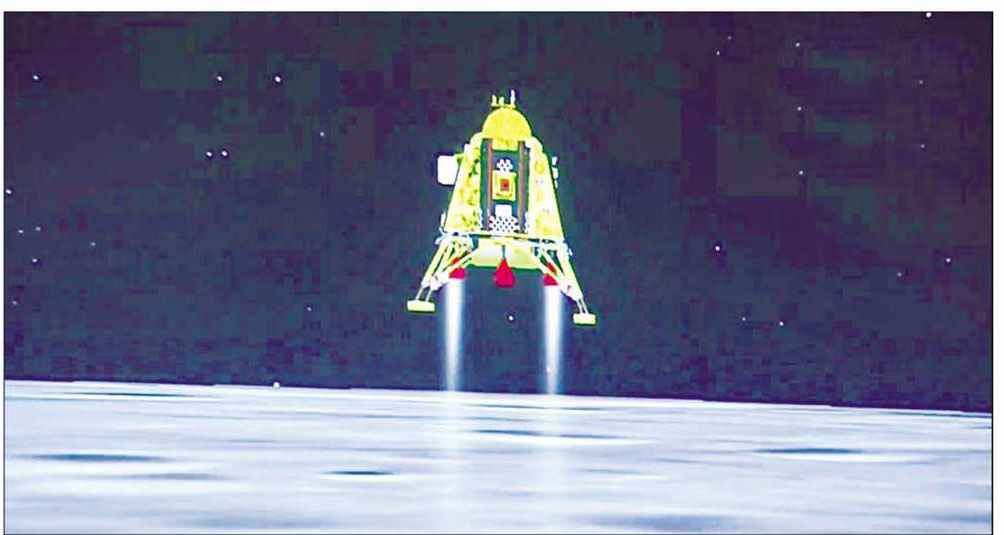
A Close look
Message others can take from Indian moon mission
Nilratan Halder | Friday, 25 August 2023
On Wednesday, August 23 last, India made history by soft-landing its lander Vikram on the moon, its south pole to be precise. When only three countries --- former Soviet Union, the USA and China --- have to their credit the remarkable feat of landing on the moon's surface, it becomes the fourth member to the elite club. But on one count, India has beaten its preceding three countries. It is the unprecedented feat of conquering the mysterious south pole thought to be storing water-based ice and precious metals. Notably, Chandrayaan-1 was the first to detect water molecules in this region. Chandrayaan-2 lander crashed in 2019. Only days before a Russian spacecraft Luna-25 crashed into the moon in an attempt to land in an area not very far from where Chandayaan-3's lander with a 26 kg rover named Pragyaan (wisdom in Sanskrit) inside it successfully landed. Notably, lander Vikram is named after the father of space research in India and founder of ISRO, Vikram Sarabhai.
By all means, this unparalleled feat has been achieved, thanks to precision science and technology of the highest order, by scientists of the Indian Space Research Organisation (ISRO). It is an entire generation of scientists devoted to space science, who have built bit by bit upon the knowledge, to make a dream come true. They have learnt from the failure of the Chandrayaan-2 mission. The earlier mission was near successful. Only the unbelievably high speed of the rover's descend could not be controlled and minimised to a bare minimum for soft-landing. This time, this fault was corrected. Very few people know that at that time the spacecraft did not crash into the moon, only the lander did. In fact the Chandrayaan-2 orbiter is still orbiting the Earth's nearest satellite. It is likely to help transmit images and data to the Earth for analysis.
Clearly, science is at its magnificent best in case of this lunar mission. But what really makes the Indian expedition to the moon distinct from similar ventures by others is the low cost. At a budget of only $75 million, this pioneering feat has been achieved. When a blockbuster Hollywood movie costs a billion dollar to make, the Indian scientists have made it happen with such a low budget. This is exactly where, countries not as resourceful as the USA and China can take inspiration for embarking on deep space exploration for the entire mankind.
What is needed is to have unfailing dedication to the cause of science and the nation's well-being. Countries that create a band of ultra rich fail to develop a matching education system and required infrastructure to nurture scientific prodigies. In fact, some even never know that they could be a version of APJ Abdul Kalam, whose humble origin did not stand on his way to becoming a rocket scientist. A natural consequence in case of those who somehow make it to higher education is brain drain from such countries because they have nowhere to contribute. Also, they do not get the recognition for their potential by below par bureaucrats and myopic politicians most of whom are after immediate gains in collusion with business cartels with no love for the country.

Sure enough, India is no exception to this socio-economic discrimination and other ills that destabilise the balance of human relations and the centre of national gravity. It is because of this Gujrat communal violence and Manipur's mayhem can still take place at a time when the ISRO brings glory to the nation. But India is a vast country and one that is full of contrasts and contradictions. Its diversity is its strength but, unfortunately, that diversity is under attack now. Poverty and deprivation have left pockets with no blessings of modern civilisation touching lives of sections of people.
Again, if precision science and technology have made their ultimate mark on lander Vikram's successful descent on the moon on Wednesday, the day also saw the tragic collapse of an under construction railway bridge in Mizoram, killing at least 26 people and injuring three ---the majority of whom were workers. This shows the contradictory levels of scientific and technological performances. There are people who would scoff at the highest level of scientific and technological feats complaining that the country may go to the moon or even beyond but cannot feed and educate all its people. They would further make a case of engineering glitches involving the under construction bridge's collapse or for that matter the worst train accident in a decade in Odisha in June last, in which 288 people were killed.
However, the truth is that if the moon landing is a scientific and technological marvel, the bridge collapse is an engineering oversight. It happens when something vital is wanting. That vital element is nothing but total devotion to the task at hand and no compromise on details.